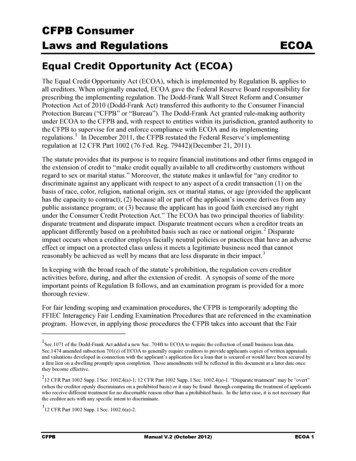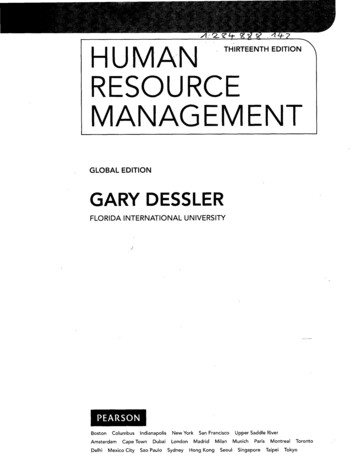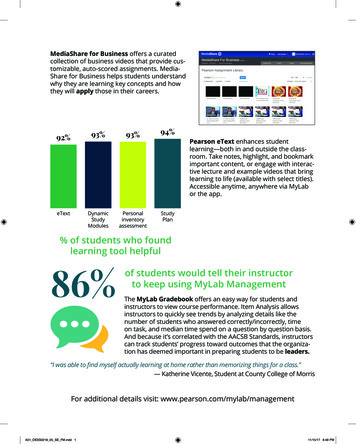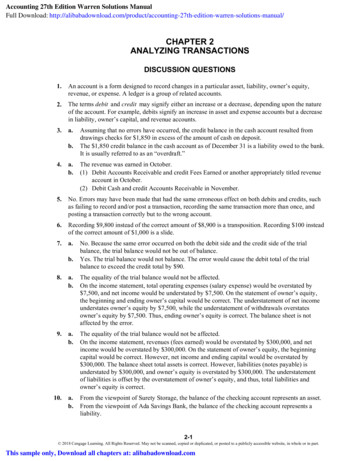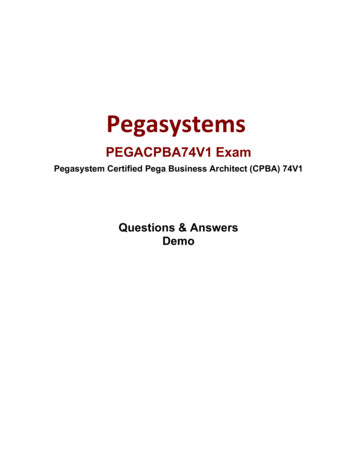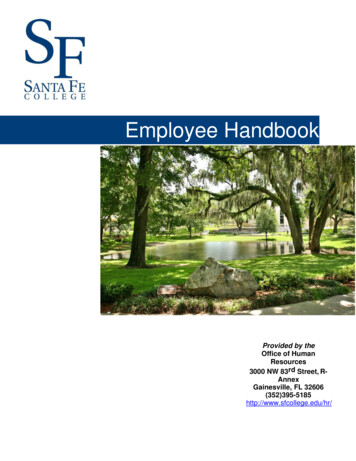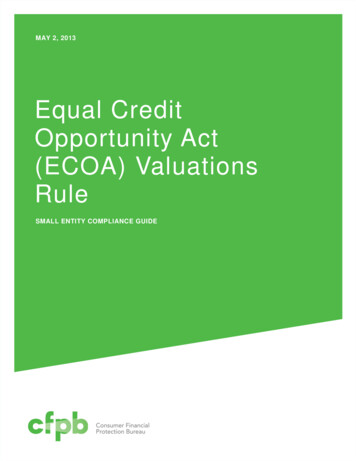
Transcription
MAY 2, 2013Equal CreditOpportunity Act(ECOA) ValuationsRuleSMALL ENTITY COMPLIANCE GUIDE1
Table of Contents1. Introduction . 5I.What is the purpose of this guide?. 6II. Who should read this guide? . 6III. Who can I contact about this guide or the Equal Credit OpportunityAct (ECOA) Valuations Rule? . 72. What is the ECOA Valuations Rule?. 8I.What is the ECOA Valuations Rule about?. 8II. When do I have to start following this rule? . 9III. What loans are covered by the ECOA Valuations Rule?(§ 1002.14(a)(1)) . 9IV. What loans are not covered by the ECOA Valuations Rule? . 103. What is a valuation of a dwelling? . 11I.What is a dwelling? (§ 1002.14(c)) . 11II. What counts as an appraisal or other written valuation?(§ 1002.14(b)(3)) . 11III. What is not considered a valuation? (Comment 14(b)(3)-3) . 124. How do I comply with the ECOA Valuations Rule? . 13I.2What do I have to do to comply with this rule? . 13
II. What text should I use in my standard disclosure notice? (AppendixC, Sample Notification Form C-9) . 14III. What are my obligations if the loan does not close or the accountdoes not open? (§ 1002.14(a)(1) and comment 14(a)(1)-4(v)). 145. How must I provide information to applicants? . 16I.How can I deliver the valuation copies to the applicants? (Comment14(a)(1)-4(i)). 16II. Can I charge for the copies? (§ 1002.14(a)(3)) . 16III. What if there is more than one applicant? Do I have to send thedisclosure and valuation copies to each of them? (Comment14(a)-1) . 17IV. When must the copies of valuations be provided to applicants? Can Isave up my valuations and send them all at once?(Comments 14(a)(1)-4(ii), 14(a)(1)-4(iii), and 14(a)(1)-6) . 17V. If I get multiple versions of a valuation, do I have to send them all tothe applicant? (Comment 14(a)(1)) . 18VI. When can the applicant waive the timing requirements of the ECOAValuations Rule? (§ 1002.14(a)(1)) . 19VII. How does a waiver work if there is more than one applicant?(Comment 14(a)-1) . 20VIII.How can an applicant give a waiver? (Comment 14(a)(1)-6) . 20IX. What happens if there is a clerical error in a valuation?(§ 1002.14(a)(1)) . 20X. A third-party provider says the valuation contains proprietaryinformation that I cannot disclose to others. How can I providea copy to the applicant? . 21XI. Can I provide more information to the applicant? . 216. What else do I need to know about the ECOA Valuations Rule? . 22I.3How do the ECOA Valuations Rule and the Appraisals for HigherPriced Mortgage Loans Rule overlap? . 22
II. This rule implements an amendment to ECOA, which deals withlending discrimination. How might discrimination occur in avaluation?. 237. Practical Implementation and Compliance Considerations . 258. Other Resources . 27I.4Where can I find a copy of the ECOA Valuations Rule and get moreinformation about it? . 27
1. IntroductionThe Equal Credit Opportunity Act (ECOA), enacted in 1974, and its implementing rules (knownas Regulation B) prohibit creditors from discriminating on the basis of race, color, religion,national origin, sex, marital status, age (provided that the applicant has the capacity to contract),because all or part of an applicant’s income derives from public assistance, or because theapplicant has in good faith exercised rights under certain credit laws, including the Truth inLending Act (TILA).In 2010, the Dodd-Frank Wall Street Reform and Consumer Protection Act (the Dodd-FrankAct) amended ECOA provisions to provide guarantees that applicants receive importantinformation about their home value estimates. In January 2013, to implement these amendments,the Consumer Financial Protection Bureau finalized the Disclosure and Delivery Requirementsfor Copies of Appraisals and Other Written Valuations Under the Equal Credit Opportunity Act(Regulation B) rule. The rule is referred to in this guide as the ECOA Valuations Rule.Before the new rule, Regulation B required only that creditors provide copies of appraisals toapplicants upon request and notify them of their right to make a request. The ECOA ValuationsRule changes both of these requirements.The ECOA Valuations Rule requires creditors to disclose to applicants that they have the rightto receive copies of appraisals and written valuations.The ECOA Valuations Rule also requires creditors to automatically send a free copy of homeappraisals and other written valuations promptly after they are completed, regardless of whethercredit is extended, denied, incomplete, or withdrawn.The new rule applies to all written valuations (not just appraisals) that you develop in connectionwith an application for covered transaction. It covers all first liens on dwellings, including closedend mortgage loans and open-end loans.5
I. What is the purpose of thisguide?This guide provides a summary of the ECOA Valuations Rule. This guide also highlights issuesthat small creditors, and those that work with them, might find helpful to consider whenimplementing the rule.The focus of this guide is the ECOA Valuations Rule (with a limited discussion of a related ruleunder TILA). This guide does not discuss other federal or state laws governing consumer accessto appraisals and other written valuations.The Bureau believes that most creditors are already providing appraisal reports for manymortgage loans due to pre-existing industry standards imposed by the government-sponsoredenterprises. However, creditors will likely need to update their processes, origination andunderwriting guidelines, software, or other aspects of their business operations to comply withthis rule.Changes related to this rule may take careful planning, time, or resources to implement. Thisguide will help you identify and plan for necessary changes.The guide summarizes the ECOA Valuations Rule, but it is not a substitute for the rule. Only therule and its Official Interpretations can provide definitive information regarding its requirements.The discussions below provide citations to the sections of the rule on the subject beingdiscussed. Keep in mind that the Official Interpretations, which provide detailed explanations ofmany of the rule’s requirements, are found after the text of the rule and its appendices. Theinterpretations are arranged by rule section and paragraph for ease of use. The complete rule,including the Official Interpretations, is available -credit-opportunity-act-regulation-b/.At the end of this guide, there is more information about the rule and a list of additionalresources.II. Who should read this guide?If your organization originates open-end or closed-end loans secured by first liens on dwellings,you may find this guide helpful. Note that credit unions that previously followed National CreditUnion Administration rules requiring them to provide appraisals only when members asked forcopies must follow this rule.This guide may also be helpful to software providers and other companies that serve as businesspartners to creditors.6
This guide will help you determine whether this rule regulates the loans you originate and if so,what your compliance obligations are.III. Who can I contact about thisguide or the Equal CreditOpportunity Act (ECOA)Valuations Rule?For more information on the rule, please contact the Bureau’s Office of Regulations at 202-4357700, or email questions to CFPB reginquiries@cfpb.gov.Email comments about the guide to CFPB TitleXIVRules@cfpb.gov. Your feedback is crucialto making sure the guide is as helpful as possible. The Bureau welcomes your suggestions forimprovements and your thoughts on its usefulness and readability.The Bureau is particularly interested in feedback relating to: How useful you found this guide for understanding the rule How useful you found this guide for implementing the rule at your business Suggestions you have for improving the guide, such as additional implementationtips7
2. What is the ECOAValuations Rule?I. What is the ECOA ValuationsRule about?The new ECOA Valuations Rule amends the appraisal provisions of ECOA’s Regulation B. Itupdates current ECOA rules to say that you must provide applicants for first-lien loans on adwelling with copies of appraisals, as well as other written valuations, developed in connectionwith the application, whether or not the applicants request copies.Under the ECOA Valuations Rule: When you receive an applicant’s application, you have three business days to notifythe applicant of the right to receive a copy of appraisals. You must promptly share copies ofappraisals and other written valuationswith the applicant. Promptly means promptly uponcompletion, or at least three business daysbefore consummation (for closed-endcredit) or account opening (for open-endcredit), whichever is earlier. Assummarized below, the OfficialInterpretations of the regulation provideexamples for guidance. (See “When mustcopies of valuations be provided to applicants?”on page 17)Implementation Tip: Look at yourunderwriting process and see what writtenestimates of value your organization iscollecting. Figure out how you will copy andshare those estimates with consumers“promptly upon completion.” Consider what,if any, review process your organizationtypically undertakes for these valuations, soyou know when they will be viewed as“completed” and can be sent to consumers.Additional guidance on the types of estimatesthat are considered “valuations” under theECOA Valuations Rule appears below. The applicant can waive the right to receive copies of the appraisal or other writtenvaluations in advance of the closing, but in those cases, you must still deliver thecopies at or prior to consummation or account opening.8
If you do not consummate the loan or open the account and the applicant hasprovided a waiver, you have 30 days after you determine that the loan will notconsummate or open to send the applicant a copy of the appraisal and other writtenvaluations.You cannot charge for copies of appraisals or other written valuations, but you can charge theapplicant a reasonable fee to reimburse you for the cost of preparing appraisals and other writtenvaluations, unless applicable law prohibits it or otherwise restricts it. You may not upchargeconsumers by adding fees to the cost of preparing the appraisal or other written valuations.II. When do I have to start followingthis rule?You must follow the ECOA Valuations Rule for applications received on or after January 18,2014. For example, an application received on January 17, 2014, for a loan not scheduled to closeuntil February 2014, would not be covered by the ECOA Valuations Rule.III. What loans are covered by theECOA Valuations Rule?(§ 1002.14(a)(1))The rule covers applications for closed-end or open-end credit secured by a first lien on adwelling. These include: Loans for business purposes (for example, a loan to start a business), investment orleisure purposes (such as a vacation home or investment property), or consumerpurposes (for example, a loan to purchase a home) Loss-mitigation transactions, such as loan modifications, short sales, and deed-inlieu transactions, if they are credit transactions covered by Regulation B Loans secured by mobile or manufacturedhomes Reverse mortgages Time-share loans if they are credittransactions covered by Regulation B (andif, as in each of the above examples, theyare secured by a first lien on a dwelling)9Implementation Tip: Plan to updateyour Regulation B appraisal notice for firstlien transactions. Once the ECOA ValuationsRule takes effect, the Regulation B appraisalnotice also will no longer be required forsecond-lien or other subordinate-lientransactions. The text of a sample notice is inAppendix C, Form C-9.
If you are unsure whether a transaction is covered, consider whether there is an “applicant” or“application” for an “extension of credit” as required by Regulation B.IV. What loans are not covered bythe ECOA Valuations Rule?The ECOA Valuations Rule does not cover second liens and other subordinate loans and loansthat are not secured by a dwelling (such as loans secured solely by land).10
3. What is a valuation of adwelling?I. What is a dwelling?(§ 1002.14(c))A dwelling is a residential structure that contains one to four units whether or not that structureis attached to real property. The term includes, but is not limited to, individual condominiumunits, mobile homes, and manufactured homes.II. What counts as an appraisal orother written valuation?(§ 1002.14(b)(3))A “valuation” is any estimate of the value of a dwelling developed in connection with anapplication for credit.Here is a nonexclusive list of valuations (Comment 14(b)(3)-1): An appraiser’s report (whether or not theappraiser is licensed or certified),including the estimate or opinion of theproperty’s value A document your staff prepares thatassigns value to the property11Implementation Tip: Most firstmortgage creditors already provide appraisalsto applicants. If you are not also sharing otherwritten valuations, you will need to updateyour systems to do so. You may also find ituseful to review your loan application andunderwriting process to identify other writtenvaluations that are developed in connectionwith first mortgage applications.
A report approved by a governmentsponsored enterprise for describing to theapplicant an estimate developed by theenterprise’s proprietary methodology ormechanism Automated valuation model reports usedto estimate the property’s valueImplementation Tip: You must sharewith applicants the valuations that secondarymarket partners develop and share with yourorganization in connection with the creditapplication process. A broker price opinion prepared by a real estate broker, agent, or sales person toestimate the property’s valueYou must also share with the applicant any attachments or exhibits that are an integrated part ofthe valuation.Keep in mind that if a valuation is developed in connection with the application, then you mustprovide a copy to the applicant, even if you do not use the valuation or you use it only for alimited purpose.III. What is not considered avaluation? (Comment 14(b)(3)-3)Not all documents that discuss or restate a property’s value are valuations. Documents thatdiscuss property value but are not valuations include: Internal documents that merely restate the estimated value of the dwelling containedin an appraisal or other written valuation you are providing to the applicant (forexample, an internal email that only mentions the appraised value in the appraiser’sreport to be provided to the applicant) Government agency statements of appraised value that are publicly available Publicly-available lists of valuations (such as published sales prices or mortgageamounts, tax assessments, and retail price ranges) Manufacturers’ invoices for manufactured homes Reports reflecting property inspections that do not provide an estimate or opinionof the value of the property and are not used to develop an estimate or opinion ofthe value of the propertyIn addition, an appraisal review that does not itself state a different estimate from the appraisalwould not be a valuation you must provide to the applicant.12
4. How do I comply withthe ECOA ValuationsRule?I. What do I have to do to complywith this rule?To comply with the ECOA Valuations Rule: You must notify the applicant in writing within three business days of application ofthe right to receive a copy of any appraisal developed in connection with theapplication. If you have an application that was not originally going to be secured by a first lienon a dwelling and you later determine that it will be secured by a first lien on adwelling, then you have three business days after you determine the change hasoccurred to notify the applicant about the right to receive appraisals. When processing an application for a closed-end loan, you must deliver copies ofappraisals and other written valuations “promptly upon completion,” or threebusiness days before consummation, whichever is earlier. For example, if a loan willclose on Friday, April 4, you must deliver the valuation no later than Tuesday,April 1. When processing an application for an open-end loan, you must deliver copies ofappraisals and other written valuations “promptly upon completion,” or threebusiness days before account opening, whichever is earlier. You cannot charge the applicant for copies of any appraisal or written valuation youprovide; however, you can charge a reasonable fee to reimburse the cost of theappraisal or other written valuation if not otherwise prohibited by law.13
For applicants who waive the right to receive the required copies at least threebusiness days before consummation or account opening, you must provide thecopies either at, or prior to, consummation or account opening.If the loan is a closed-end, higher-priced transaction, you must also determine whether it iscovered by the TILA appraisal requirements in the Appraisals for Higher-Priced Mortgage LoansRule (HPML Appraisal Rule) under Regulation Z.The HPML Appraisal Rule is further discussed below. (See “How do the ECOA Valuations Rule andthe Appraisals for Higher-Priced Mortgage Loans Rule overlap?” on page 22.) For more information onthat rule, see als-for-higher-pricedmortgage-loans or consult the Bureau’s Small Entity Compliance Guide: TILA Higher-PricedMortgage Loans Appraisal Rule.The ECOA Valuations Rule does not provide a definition of “business days” for purposes of thetiming of the consumer notice and for providing copies of appraisals and other writtenvaluations.For loans covered by the HPML Appraisal Rule, consult the Bureau’s Small Entity ComplianceGuide: TILA Higher-Priced Mortgage Loans Appraisal Rule.For other loans, you can apply your own reasonable definition, which may include countingSaturdays – as provided, for example, in the alternative definition in Regulation Z, § 1026.2(a)(6).II. What text should I use in mystandard disclosure notice?(Appendix C, Sample NotificationForm C-9)The sample notice contained in an appendix to Regulation B states:“We may order an appraisal to determine the property’s value and charge you for this appraisal.We will promptly give you a copy of any appraisal, even if your loan does not close. You can payfor an additional appraisal for your own use at your own cost.”III. What are my obligations if theloan does not close or theaccount does not open?14
(§ 1002.14(a)(1) and comment14(a)(1)-4(v))If you determine that you are not going to close a loan or open a credit line, you still have to givethe applicant a copy of the appraisal and other written valuations “promptly upon completion.”If the applicant has waived that deadline, you must provide copies of the appraisal and otherwritten valuations to the applicant 30 days after you determine the transaction will not close.15
5. How must I provideinformation toapplicants?I. How can I deliver the valuationcopies to the applicants?(Comment 14(a)(1)-4(i))Send the copies to the applicant’s last-known physical or electronic address. Delivery occursthree business days after you mail or transmit the copies, or whenever you have evidenceindicating that the applicant received the copies.For electronic delivery, you must obtain the applicant’s consent under the Electronic Signaturesin Global and National Commerce Act (E-Sign Act). You will find information about E-Sign l/pdf/X-3.1.pdf.II. Can I charge for the copies?(§ 1002.14(a)(3))You cannot charge fees for photocopying or to cover the cost of postage to mail copies ofappraisals or other written valuations.You may charge a reasonable fee to cover the cost of developing an appraisal or other writtenvaluation, except as otherwise provided by law. You cannot condition providing copies onpayment of this fee, however. If you receive a completed valuation, you must promptly provide itto the applicants, even if they do not pay for it. To ensure payment, you can collect paymentbefore ordering the appraisal or other written valuation, subject to restrictions for somemortgages under Regulation Z (§ 1026.19(a)(ii)). Alternatively, if you collect payment at closing,you can also provide the copy at that time if you obtain a waiver.16
III. What if there is more than oneapplicant? Do I have to send thedisclosure and valuation copiesto each of them? (Comment14(a)-1)If there is more than one applicant, you may give the disclosure and copies to one applicant.However, if it is readily apparent that one of the applicants is the primary applicant, thedisclosure and copies should be given to that applicant.IV. When must the copies ofvaluations be provided toapplicants? Can I save up myvaluations and send them all atonce? (Comments 14(a)(1)-4(ii),14(a)(1)-4(iii), and 14(a)(1)-6)You must send valuations promptly upon completion. If one valuation is completed, it may bepossible to wait a few days for another valuation to be completed, as long as copies are providedat least three business days before closing. However, waiting for longer than a few days reducesthe likelihood that delivery of the first valuation will be prompt. If you obtain a waiver from theapplicant, you can wait until closing to provide the valuations all at once.The “promptly upon completion” standard does not refer to a particular time period. Itsapplication and meaning depend on the facts and circumstances, including (but not limited to): When you receive the appraisal or other written valuation The extent of any review or revisions you do after receiving it“Completion” of an appraisal or other written valuation occurs when you get the last version ofthat appraisal or other written valuation, or when it is apparent to you that there will be only oneversion of that appraisal or other written valuation.17
Examples in which the “promptly upon completion” standard would be satisfied include (butare not limited to) the following. These examples assume the applicant receives the valuationcopy no later than three business days before consummation or account opening: Sending a copy of an appraisal within a week of review by underwriting: Forexample, 15 days after application, your underwriting department reviews andapproves an appraisal. You send a copy to the applicant one week later. Not providing a copy of a draft appraisal a reviewer is revising, whileproviding a copy of the revised appraisal within a week of the reviewerfinding it acceptable: For example, you receive a revised appraisal 45 days afterapplication and your underwriting department approves it. You have not sent theinitial appraisal to the applicant. You send the revised appraisal within a few days. Sending a copy of an automated valuation model (AVM) report within a weekafter receiving it: For example, you receive an AVM report five days afterapplication and treat it is as complete. Twelve days after the application (a weekafter receiving the AVM report), you send a copy to the applicant.Examples of cases in which the “promptly upon completion” standard would not be satisfiedinclude (but are not limited to): Delaying too long after completing an appraisal or other written valuationbefore providing a copy: For example, 12 days after application, you receive andapprove an appraisal. You wait to provide a copy to the applicant until 42 days afterapplication. Delaying providing a copy of one written valuation too long while waiting forcompletion of a second written valuation: For example, you receive and approvean AVM report five days after application. You order an appraisal and the initialversion of the appraisal is deficient. It takes until day 35 to get the revised appraisal.You hold the AVM report and send both the AVM and the appraisal to theapplicant on day 35. While you provided the appraisal report promptly uponcompletion, you did not provide the AVM report promptly upon completion.V. If I get multiple versions of avaluation, do I have to send themall to the applicant? (Comment14(a)(1))The reference to providing copies of “all” appraisals and other written valuations does not referto all versions of the same appraisal or other written valuation. If you get multiple versions of anappraisal or other written valuation, you have to give the applicant only the latest version.18
If you give the applicant a copy of an appraisal or other written valuation and then you get arevised version of the same appraisal or written valuation, then you must send the updatedversion to the applicant as well. You cannot charge a fee for providing the copy of an updatedvaluation.If you have only one version of an appraisal or other valuation, then the copy of that version isthe one you give the applicant.VI. When can the applicant waive thetiming requirements of the ECOAValuations Rule?(§ 1002.14(a)(1))An applicant may waive the timing requirement of the ECOA Valuations Rule and agree toreceive copies of valuations at or before consummation or account opening, except whereotherwise prohibited by law.You must get the applicant’s waiver at least three business days prior to consummation oraccount opening unless a clerical error is involved. (See “What happens if there is a clerical error in avaluation?” on page 20.)The applicant can give you the waiver in writing or orally.When an applicant has provided a waiver and you do not consummate or open the account, youmust send the applicant the valuation no later than 30 days after you determine the closing willnot occur.Note that if the transaction is a higher-priced mortgage loan covered by the 2013 Appraisals forHigher-Priced Mortgage Loans Rule, then under that rule, you must provide copies ofwritten appraisals no later than three business days before consummation. There is no waiveroption for appraisals covered by that rule. aisals-for-higher-priced-mortgage-loans/formore information about this rule.19
VII. How does a waiver work if thereis more than one applicant?(Comment 14(a)-1)Where there are multiple applicants, one applicant may provide a waiver, but it must be theprimary applicant where one is readily apparent.VIII. How can an applicant give awaiver? (Comment 14(a)(1)-6)You can accept an oral or written statement from an applicant. For example, you can obtain awaiver from an applicant through and e-mail, phone call, or some other means.IX. What happens if there is aclerical error in a valuation?(§ 1002.14(a)(1))To avoid interrupting transactions at the last minute, when a clerical correction is made in anappraisal or other written valuation that you have already given the applicant, you can have theapplicant waive the right to receive the revision three business days before consummation oraccount opening. As noted above, the waiver can be oral or written.To use this exemption, you must meet five criteria:1. The revisions must be solely to correct clerical errors in that appraisal or otherwritten valuation.2. The revisions must have no impact on the estimated value.3. The revisions must have no impact on the calculation or methodology used to derivethe estimate.4. The applicant receives the revised appraisal or other written valuation at or prior toconsummation or account opening.5. The applicant must have already received the valuation that is being corrected (precorrection) either promptly upon completion or three business days beforeconsummation or account opening, whichever is earlier.20
X. A third-party provider says thevaluation contains proprietaryinformation that I cannot discloseto others. How can I provide acopy to the applicant?Some providers of valuations, such as governmentsponsored enterprises (GSEs), have developed specialforms you can use to provide valuations to customers.Providing a copy on a GSE-approved form is anacceptable way to comply with the rule. Creditorsshould consult applicable GSE program guides todetermine the procedures for providing consumerswith copies of valuation estimates provided by GSEs.Implementation Tip: You may find ituseful to review your contracts with valuationproviders to be sure that th
for Copies of Appraisals and Other Written Valuations Under the Equal Credit Opportunity Act (Regulation B) rule. The rule is referred to in this guide as the ECOA Valuations Rule. Before the new rule, Regulation B required only that creditors provide copies of appraisals to applicants upon request and notify them of their right to make a request.


